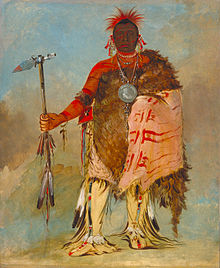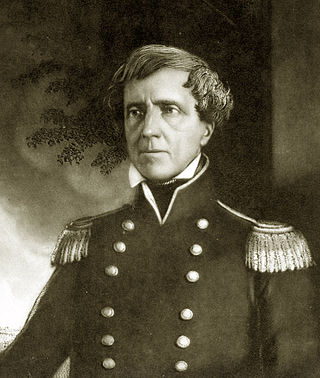
The Second Dragoon Expedition of 1835 (also called the Dodge Expedition) left Fort Leavenworth, unorganized territory May 29, 1835, charged with contacting the Indian tribes across the Central Plains to the Rockies as far west as the Mexican border.

The Second Dragoon Expedition of 1835 (also called the Dodge Expedition) left Fort Leavenworth, unorganized territory May 29, 1835, charged with contacting the Indian tribes across the Central Plains to the Rockies as far west as the Mexican border.

Traveling first up the Platte River they made contact with the Otoe, Omaha, Grand Pawnee, and Arickaree tribes. Continuing south along the front range of the Rockies, they reached Bent's Fort on August 6. At Bent's Fort the expedition held councils with the Arapahoes, Cheyennes, Black Feet, Gros Ventres, and others. On August 12, 1835 the Dragoons began the return march from Bent's Fort, following the Santa Fe Trail eastward. They arrived at Council Grove, Kansas the evening of September 8, 1835.

Between Council Grove and Hundred and Ten Mile Creek the expedition experienced its only loss, the death of 23 year old, Private Samuel Hunt on September 11, 1835. In Colonel Dodge's Journal he wrote, "On the 11th a man of company “A” died—the first death that has occurred on our whole march, and the only severe sickness. The colonel directed him to be buried on a high prairie ridge, and a stone placed at the head of the grave, with his name and regiment engraved thereon. Continued the march; crossed the Hundred-and ten-mile creek, and entered upon the dividing ridge between the Kansas and Osage rivers; passed Round and Elm Groves, and arrived at the crossing of the Kansas, at Dunlap's Ferry, on the 15th; crossed the river, and on the 16th arrived at Fort Leavenworth."

Stephen Watts Kearny was one of the foremost antebellum frontier officers of the United States Army. He is remembered for his significant contributions in the Mexican–American War, especially the conquest of California. The Kearny code, proclaimed on September 22, 1846, in Santa Fe, established the law and government of the newly acquired territory of New Mexico and was named after him. His nephew was Major General Philip Kearny of American Civil War fame.

Moses Henry Dodge was an American politician and military officer who was Democratic member to the U.S. House of Representatives and U.S. Senate, Territorial Governor of Wisconsin and a veteran of the Black Hawk War. His son, Augustus C. Dodge, served as a U.S. Senator from Iowa; the two were the first and so far the only father-son pair to serve concurrently in the Senate, which they did from 1848 to 1855.

The Sioux Wars were a series of conflicts between the United States and various subgroups of the Sioux people which occurred in the later half of the 19th century. The earliest conflict came in 1854 when a fight broke out at Fort Laramie in Wyoming, when Sioux warriors killed 31 American soldiers in the Grattan Massacre, and the final came in 1890 during the Ghost Dance War.

The Powder River Expedition of 1865 also known as the Powder River War or Powder River Invasion, was a large and far-flung military operation of the United States Army against the Lakota Sioux, Cheyenne, and Arapaho Indians in Montana Territory and Dakota Territory. Although soldiers destroyed one Arapaho village and established Fort Connor to protect gold miners on the Bozeman Trail, the expedition is considered a failure because it failed to defeat or intimidate the Indians.

The 1st Cavalry Regiment is a United States Army regiment that has its antecedents in the early 19th century in the formation of the United States Regiment of Dragoons. To this day, the unit's special designation is "First Regiment of Dragoons". While they were the First Regiment of Dragoons another unit designated the 1st Cavalry Regiment was formed in 1855 and in 1861 was re-designated as the 4th Cavalry Regiment. The First Dragoons became the 1st Cavalry Regiment since they were the oldest mounted regiment.
The 3rd Wisconsin Cavalry Regiment was a volunteer cavalry regiment that served in the Union Army during the American Civil War.

Fort Gibson is a historic military site next to the modern city of Fort Gibson, in Muskogee County Oklahoma. It guarded the American frontier in Indian Territory from 1824 to 1888. When it was constructed, the fort was farther west than any other military post in the United States. It formed part of the north–south chain of forts that was intended to maintain peace on the frontier of the American West and to protect the southwestern border of the Louisiana Purchase. The fort succeeded in its peacekeeping mission for more than 50 years, as no massacres or battles occurred there.

The First Dragoon Expedition of 1834 was an exploratory mission of the United States Army into the southwestern Great Plains of the United States. It was the first official contact between the American government and the Southern Plains Indians.
The Battle of Middle Boggy Depot, also known as the Battle of Middle Boggy River or simply Battle of Middle Boggy, took place on February 13, 1864 in Choctaw Indian Territory, 4 miles (6.4 km) south of what is now Allen in Pontotoc County, Oklahoma. Advancing down the Dragoon Trail toward Fort Washita, Union Colonel William A. Phillips sent out an advance of approximately 350 men from the 14th Kansas Cavalry and two howitzers to attack a Confederate outpost guarding the Trail's crossing of Middle Boggy River. The Confederate force was led by Captain Jonathan Nail and composed of one company of the First Choctaw and Chickasaw Cavalry, a detachment of the 20th Texas Cavalry and part of the Seminole Battalion of Mounted Rifles. The outpost was about 12 miles (19 km) from Muddy Boggy Depot, which was held by the Confederates. The Encyclopedia of Oklahoma History and Culture says that the battlefield was 15 miles northeast of the depot, whereas the battlefield marker says the distance was 12 miles. The Confederate force at the outpost, consisting of 90 poorly armed men, were caught off guard when Willetts attacked them. Outnumbered and outgunned, the Confederates held off the Union cavalry attack for approximately 30 minutes before retreating to the rest of Lt. Col. John Jumper's Seminole Battalion, who were not at the main skirmish. The Confederates retreated 45 miles (72 km) southwest down the Dragoon Trail. The Union advance continued south toward Ft. Washita the next day, but when the expected reinforcements did not arrive Philips' Expedition into Indian Territory stalled on February 15, near old Stonewall.

Samuel Johnson Crawford was a Union Army officer during the American Civil War, and the third Governor of Kansas (1865–1868). He also served as one of the first members of the Kansas Legislature.

During the American Civil War, most of what is now the U.S. state of Oklahoma was designated as the Indian Territory. It served as an unorganized region that had been set aside specifically for Native American tribes and was occupied mostly by tribes which had been removed from their ancestral lands in the Southeastern United States following the Indian Removal Act of 1830. As part of the Trans-Mississippi Theater, the Indian Territory was the scene of numerous skirmishes and seven officially recognized battles involving both Native American units allied with the Confederate States of America and Native Americans loyal to the United States government, as well as other Union and Confederate troops.

Matthew Arbuckle (1778–1851) was a career soldier in the US Army closely identified with the Indian Territory for the last thirty years of his life.
The 8th Kansas Infantry Regiment was an infantry regiment that served in the Union Army during the American Civil War.
The 7th Kansas Cavalry Regiment was a cavalry regiment that served in the Union Army during the American Civil War.
The 11th Kansas Volunteer Cavalry Regiment was a cavalry regiment that served in the Union Army during the American Civil War.
The 15th Kansas Volunteer Cavalry Regiment was a cavalry regiment that served in the Union Army during the American Civil War and American Indian Wars.

The Trapper's Trail or Trappers' Trail is a north-south path along the eastern base of the Rocky Mountains that links the Great Platte River Road at Fort Laramie and the Santa Fe Trail at Bent's Old Fort. Along this path there were a number of trading posts, also called trading forts.

Enoch Steen was a United States military officer and western explorer. He joined the United States Army in 1832, serving at posts throughout the United States, including many remote locations in the west. During his military service, Steen explored parts of the western United States including large areas of southern New Mexico and southeastern Oregon. He served as the commander of several Union Army forts during the American Civil War. Today, there are landmarks in Oklahoma, Oregon, and New Mexico named in his honor; however, many of the place names are misspelled as Stein.
The history of Cleveland County, Oklahoma refers to the history of a county in the U.S. state of Oklahoma, and the land on which it developed prior to 1907 statehood. Prior to European colonization, the land represented the edge of the domain of the Plains Indians. France and Spain both colonized and explored the area before it became part of the United States via the Louisiana Purchase. It became part of the territory of the United States and tribal land and eventually part of the U.S. state of Oklahoma.
The Powder River Battles were a series of battles and skirmishes fought between September 1–15, 1865 by United States soldiers and civilians against Sioux, Cheyenne, and Arapaho warriors. The fighting occurred along the Powder River in Montana Territory and Dakota Territory, in present-day Custer and Powder River counties, Montana and northeastern Wyoming.